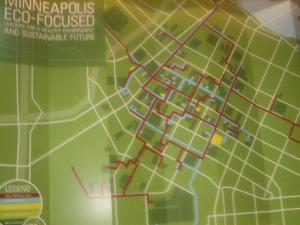If you attended the Annual Meeting in Minneapolis this year, you might have caught the following diagram on display at the convention center:
 This diagram shows the stream distribution lines of Minneapolis' district energy system and was on display at the Minneapolis Convention Center during the Annual Meeting.
This map illustrates the elaborate district energy system owned and operated by NRG Therman in Minneapolis. The system serves 130 blocks in downtown Minneapolis and was originally established in 1926 for ten buildings.
The district energy system provides steam and hot water for space heating, domestic hot water and humidification, and chilled water for air conditioning in Minneapolis.
You can learn more about this Minneapolis asset here. St. Paul is part of a similar system, which you can read about at this District Energy website. District energy is an efficient way of sharing heat to service buildings within a given area without installing multiple heat- or electricity-generating units on-site and, in the case of my city, Seattle, can also offer the opportunity to employ use of what are deemed "renewable" fuel sources.
Even if the infrastructure is not in place to allow such a system in every city--I understand upfront capital costs for installation might be high--but this seems like yet another example of a system well-worth the expenditure to minimize long-term energy costs and instantly increase energy efficiency.
Does your city make use of district energy? If not, what are some reasons you can cite for why this might not be a reasonable system for your city to implement?
This diagram shows the stream distribution lines of Minneapolis' district energy system and was on display at the Minneapolis Convention Center during the Annual Meeting.
This map illustrates the elaborate district energy system owned and operated by NRG Therman in Minneapolis. The system serves 130 blocks in downtown Minneapolis and was originally established in 1926 for ten buildings.
The district energy system provides steam and hot water for space heating, domestic hot water and humidification, and chilled water for air conditioning in Minneapolis.
You can learn more about this Minneapolis asset here. St. Paul is part of a similar system, which you can read about at this District Energy website. District energy is an efficient way of sharing heat to service buildings within a given area without installing multiple heat- or electricity-generating units on-site and, in the case of my city, Seattle, can also offer the opportunity to employ use of what are deemed "renewable" fuel sources.
Even if the infrastructure is not in place to allow such a system in every city--I understand upfront capital costs for installation might be high--but this seems like yet another example of a system well-worth the expenditure to minimize long-term energy costs and instantly increase energy efficiency.
Does your city make use of district energy? If not, what are some reasons you can cite for why this might not be a reasonable system for your city to implement?
Do you agree that this is an effective use of generated heat?
Comments
- Log in to post comments
- Log in to post comments





